10 Tips for Limewashing Your Home
Have you wanted to Limewash your home, but have been hesitant to start? Today, I’m sharing our 10 Tips for Limewashing Your Home.
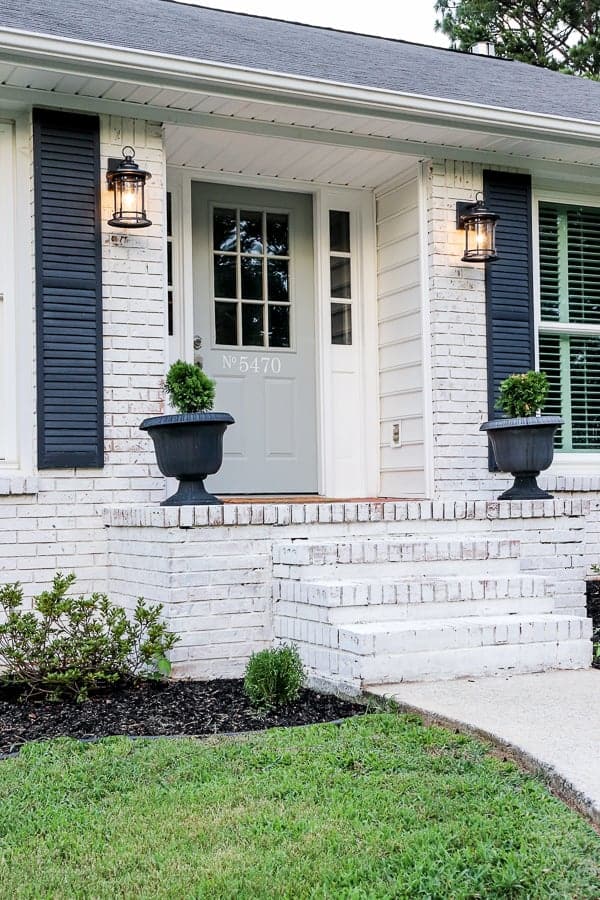
When we set off to transform the exterior of our home, I had no idea it would take us to where we are today!
The pandemic hit shortly after we had limewashed our second home. As musicians, we found ourselves scrambling for additional income when the world shut down.
This has inspired Trent to start his own Limewashing Business!
It’s been almost 2 years of watching Trent grow his successful company and we’ve learned a lot over those years.
We thought sharing these tips with you would be a great way to help you learn more about the application process, decide if this is a diy project you want to tackle, or help with any hurdles you may come across.
10 Tips for Limewashing your Home
(Some affiliate links are provided below. Full disclosure here.)
Before we begin, let us tell you about Romabio Classico Limewash and how we stumbled upon this amazing company.
What is Classico Limewash?

When we first thought of painting the brick siding of our Tennessee home, we were really worried about applying Latex Paint.
Regular paint may be an easy application, but it can cause major issues. Within 4-5 years, you may find chipping and flaking on the exterior of your home because regular paint just sits on top of the brick and trapped moisture has no where to go.
After much research, we were so excited that we found Romabio Classico Limewash. Unlike traditional paint, it absorbs into porous surfaces, like unsealed brick or stone.
It is made from crushed limestone and comes from the dolomite lime mines in northern Italy and is an authentic slaked-lime paint.
Lime wash is known for becoming part of the masonry surface it is applied to. In fact, it actually calcifies to the surface allowing the brick to still breathe and wick that moisture away from the home.
Limewash paint has been around since roman times so it stands the test of time.
Romabio offers a product that is user friendly, as well as environmentally friendly which made this DIY-er want to give it a try!
We wanted a technique that was easy to apply, offered coverage but also didn’t harm the brick.
TIP ONE: Before you begin, check if you have absorbent brick
This is a must do! Even though it appears your brick is unpainted, what you may not know is if it is sealed or not.
What you need to do is check the porosity of the surface.
The reason being is that limewash is known for becoming part of the masonry surface it is applied to. In fact, it actually calcifies to the surface allowing the brick to still breathe and wick that moisture away from the home.
In other words, squirt some clean water onto the brick. If it beads up, similar to water on tile, then there is a barrier in place that won’t allow the Lime wash to be absorbed into the brick.
However, if your brick turns dark and you can see the water absorbing into the brick, then you are ready to proceed!
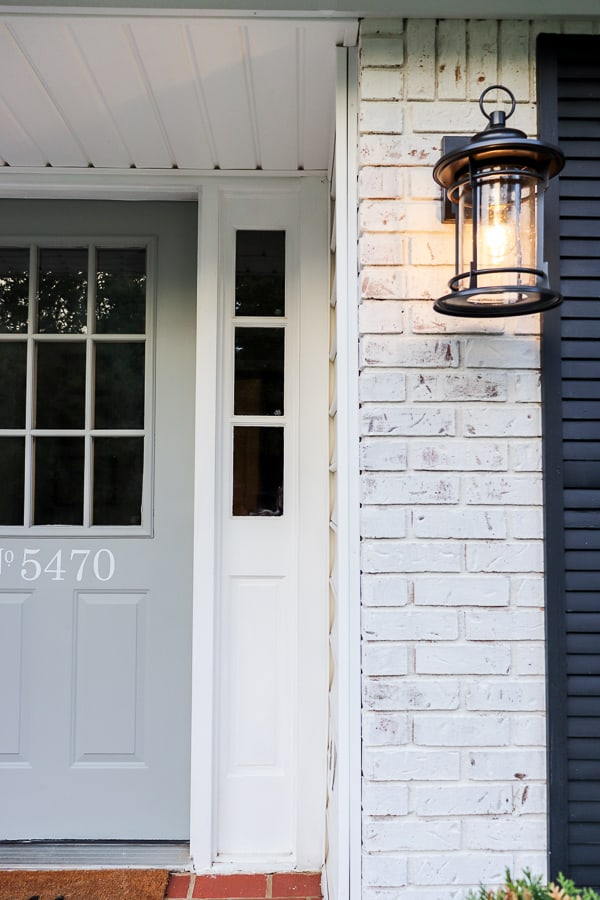
TIP TWO: Depending on the absorbency of your brick, you may have to purchase more
We noticed about halfway through the process that we were running low on our Classico Limewash.
I called and spoke to Romabio about it and was told that some brick is more absorbent than others.
When painting, if you notice the brick is dry within moments, you may have highly absorbent brick.
Even though we calculated our linear square footage properly (multiply the height and width of each wall and add them all together), we needed to order more to complete the job.
This could also be why we needed to wet the brick more often!
Also, if you have larger grout lines, that is another ledge of surface that needs to be covered, and can cause you to have to order more.
So make that extra allowance in the budget in case you have to purchase more.
TIP THREE: Watch your heat and humidity / shade and sun
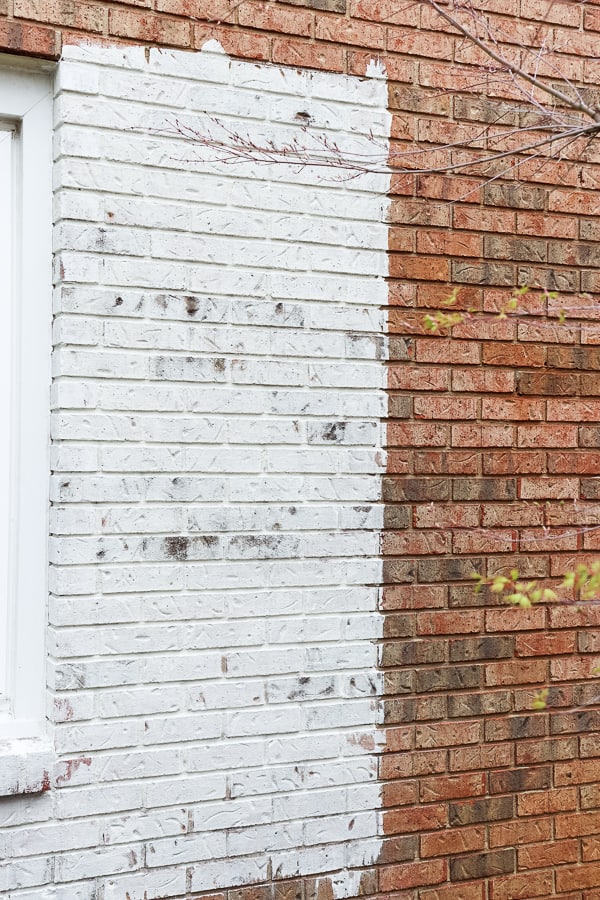
We quickly learned that limewashing our home here in Birmingham was much different than what we experienced with our Tennessee Home.
There is just enough variation in climate and humidity and we could tell when we started Limewashing.
According to Romabio’s instructions, you wet the brick with a garden hose prior to application. This helps with the calcification process as the Lime wash hardens to the brick.
With our heat and humidity, we noticed the brick needed to be wet more often.
Take that into account if you are in a hot and humid environment. What we found to be most successful was working in smaller sections, rewetting the brick as needed.
Make sure to adhere to the temperature limitations as specified. Don’t apply under 50 degrees and over 90 degrees.
Another thing to consider to not do an application of limewash in the full sun.
There’s a phrase we use often and that is “Chase the Shade.”
You shouldn’t put a coat of Classico Limewash onto a dry surface and if you are painting in direct sunlight, you may find that your brick doesn’t stay wet for long.
TIP FOUR: Create test samples
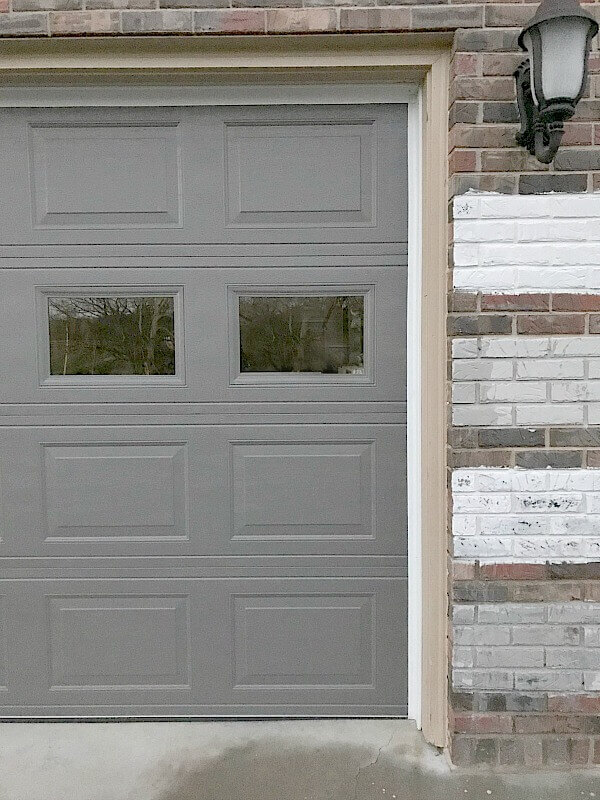
One thing Trent has learned most is the finding out exactly the look the homeowner wants and how to achieve that distressed look for an exterior limewash.
It’s best to choose an inconspicuous spot, like behind the HVAC units, or on an unseen side of the house.
The best part about Romabio’s formulation is that you can play around with dilution rates and distressing techniques.
This also works if you are torn between two colors.
On our Tennessee home, I used Avorio White and Nube Gray and created test panels to see which look and color we liked best.
TIP FIVE: Diluting the limewash
Romabio Classico Limewash is intended to be diluted and dilution rates can vary.
Then you mix, mix, mix it! A painters paddle that attaches to a drill makes the mixing process easier.
Here is how a batch of limewash looks diluted and thoroughly mixed.
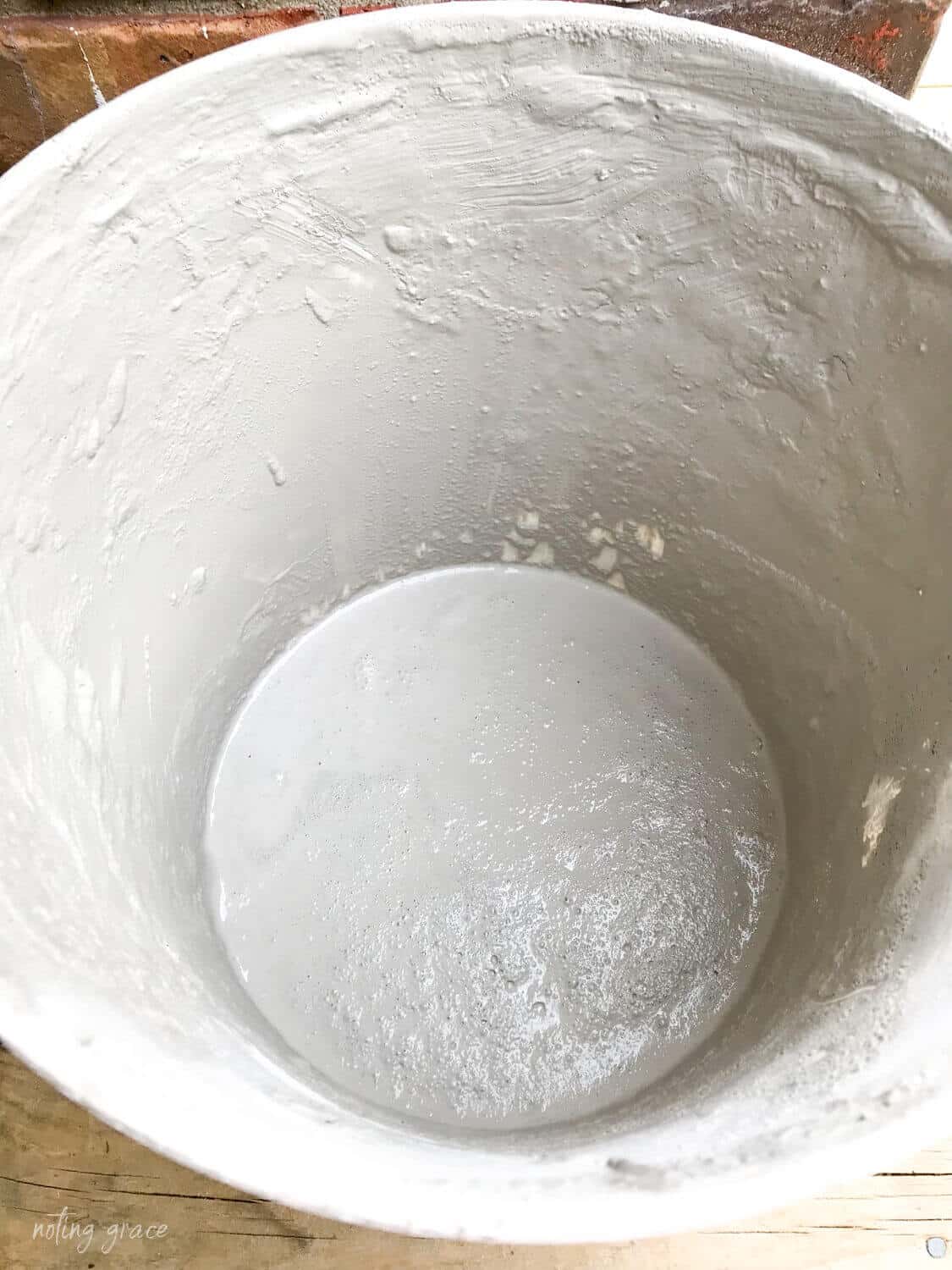
You mix until it’s the ideal consistency of whole milk. Not too thick nor too watery.
If you add too much water, no problem – just add some more limewash until it’s the consistency you like. I like to start with less water and add more as I go.
There’s really not one correct ratio for Classico Limewash. Since it’s a dilutable product, there is a lot of forgiveness in this step.
It truly can vary based on the look you are wanting to achieve.
In the next step, we’ll share how dilution rates can help with distressing the brick.
TIP SIX: Distressing tricks and tips

After you mix a batch of limewash, you apply it to the brick.
It’s best to use varying brush strokes to make sure the mortar lines and brick are fully covered.
And don’t be scared if it looks a bit translucent while wet – Romabio tells us that’s how it’s supposed to look at first.
Just apply a thin layer. It will have a different look while it’s wet, but will dry to a lighter, solid finish.
Here’s a pic of brick half wet/ half dry.
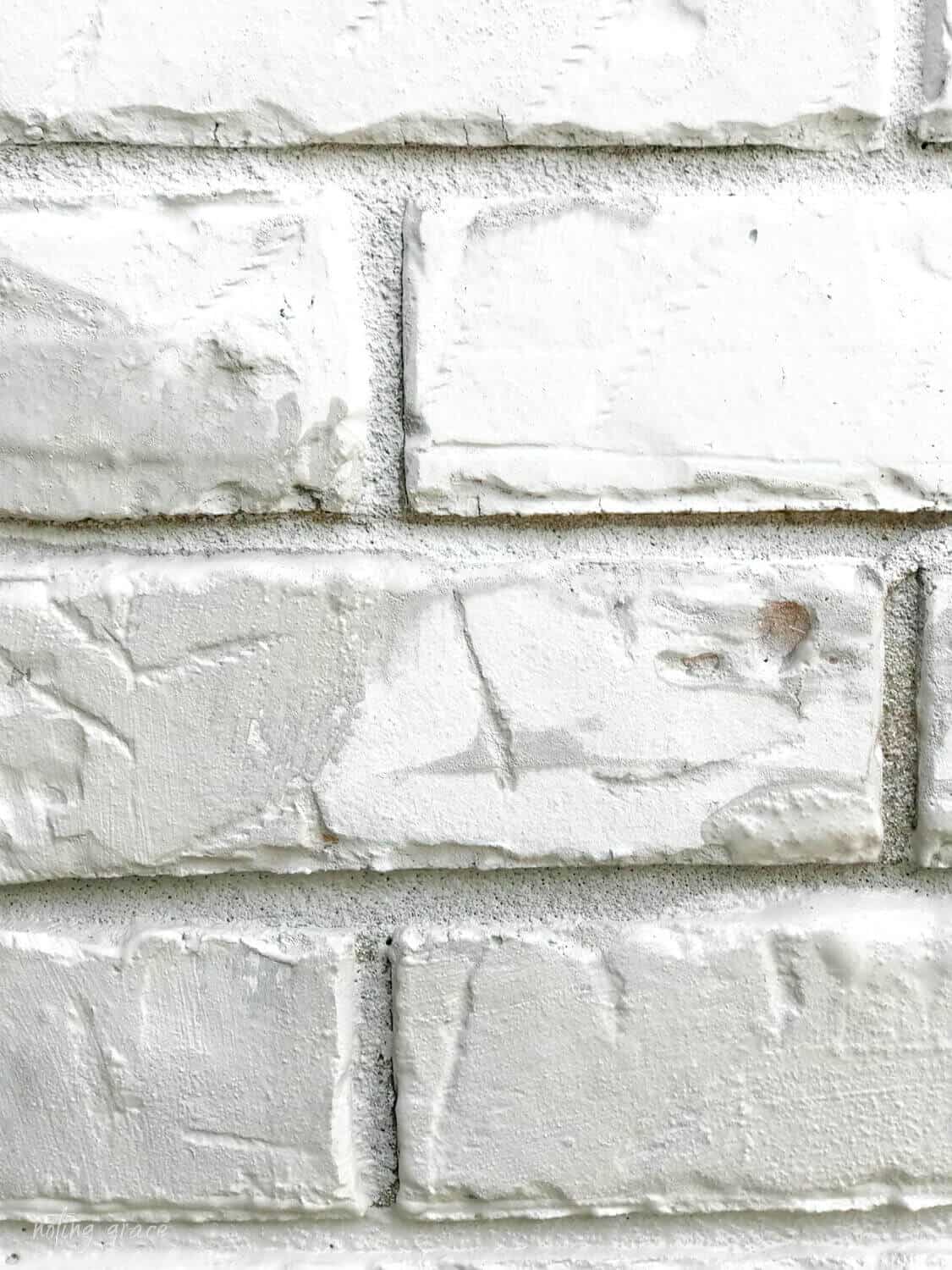
The lighter color is the dried section.
Watch for the brick to start turning to a solid finish.
This is the sweet spot to know when to take your garden hose and start rinsing the brick away.
This time, we opted to start the distressing with a light rinse off.
What’s great is that you can distress it to your liking – there’s no right or wrong way!
We started with a heavily distressed look, but it seemed to be too much.
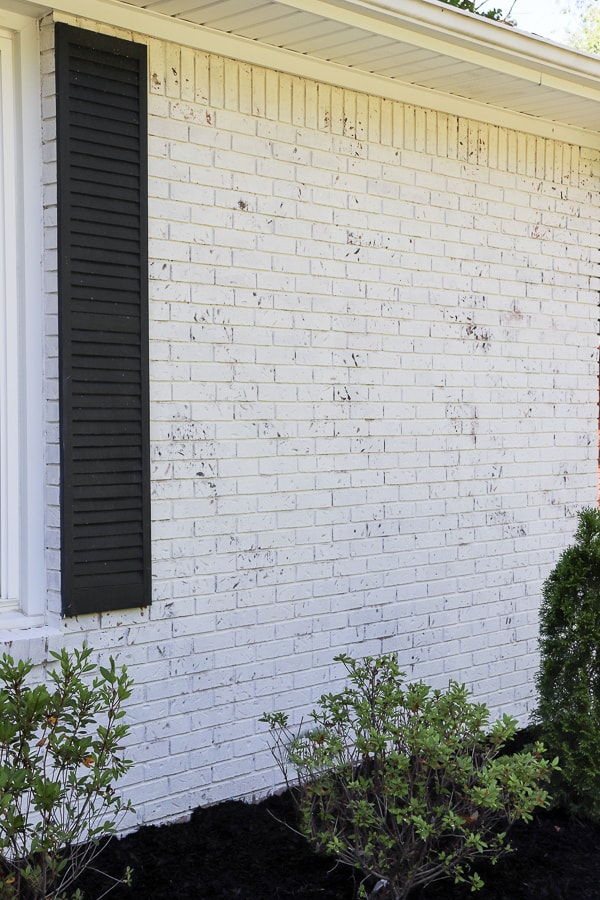
We found that with our absorbent brick, we needed to start distressing about 20 minutes after application.
Earlier than that resulted in too much being washed off, and any time later the lime wash was already calcified.
So we found that if we used our pressure washer – very lightly – worked on the calcified brick.
That being said, use caution because you can take too much off. Our pressure washer has different gauges of PSI and we used the lowest one.
TIP SEVEN: Interior Limewash application
Obviously, you can’t bring a garden hose into your living room to squirt limewash off your brick fireplace or wall.
So how do you distress interior brick differently than exterior applications?
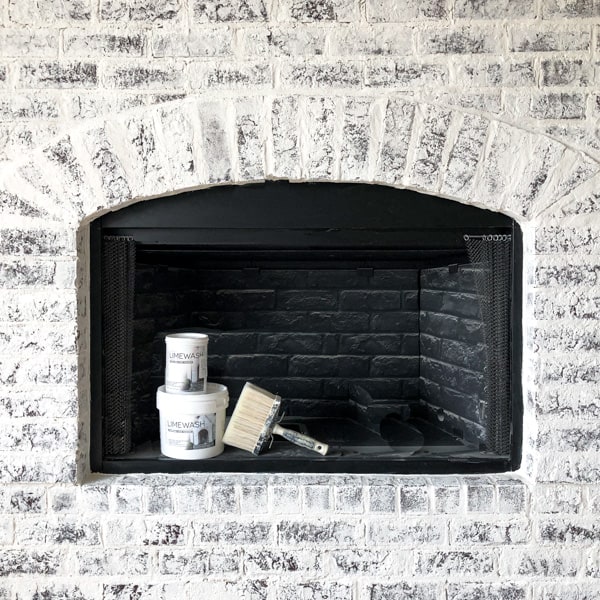
First off, you don’t need to mix 5-gallon buckets of limewash.
Romabio’s Classico Limewash comes in a variety of sizes and most of the time, a 1 quart container is all you need for an average sized fireplace.
Using a spray bottle, dampen the brick surface.
You can use a smaller brush and apply a thin coat of limewash.
Have a damp rag handy and use the rag and spray bottle to start distressing as you go.
Once it starts to dry, you can go back and take more off. And if you took off too much, then just reapply a bit more.
For our boys’ bathroom, I wanted a subtle texture to the brick accent wall we created.
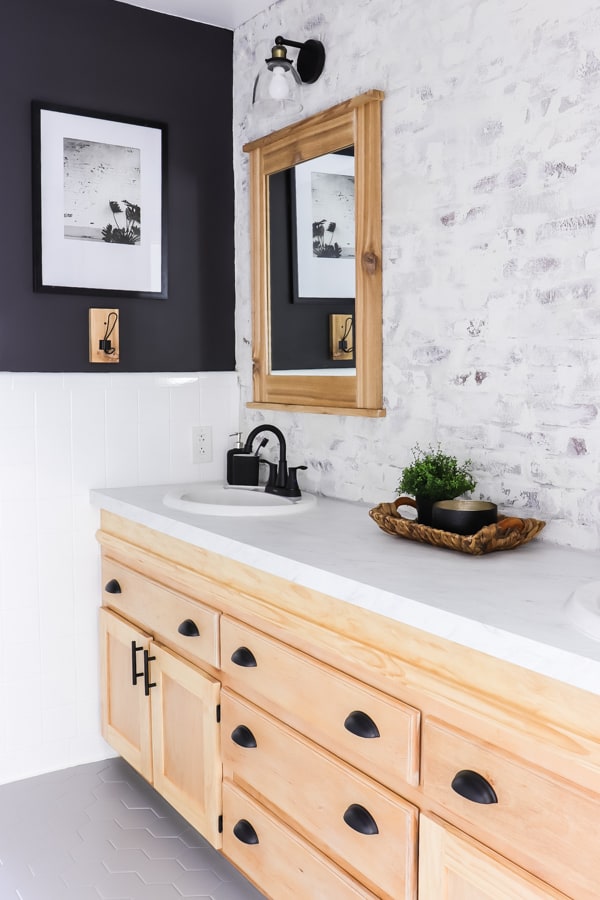
I used 3 different colors of limewash and a very lightly diluted limewash.
It was almost the consistency of lime putty.
Then we played around until we got the look we wanted with very light distressing.
TIP EIGHT: Play around with dilution rates
This is my favorite thing about the Classico Limewash.
After seeing all the different looks Trent has created on all the homes he’s painted, every one of them is unique.
And that’s because you can truly customize the process.
The general rule of thumb is to dilute the limewash with 50 percent water.
But with heavier distressing, you can dilute it with equal parts water.
TIP NINE: If you are going solid, consider using Masonry Flat

Not everyone likes the distressed look of limewash.
And you can apply 2 coats of Romabio’s Classico Limewash with beautiful results.
But the Masonry Flat has the same flat sheen as the Limewash and comes with a guarantee to not chip or flake for 20 years with a 2 coat finish.
So if you were going to apply the same number of coats with either product, it’s worth switching to Masonry Flat to get that guarantee.
The Masonry Flat also comes in two different types of bases, so you can have it tinted to darker colors.
TIP TEN: Know when to ask for help
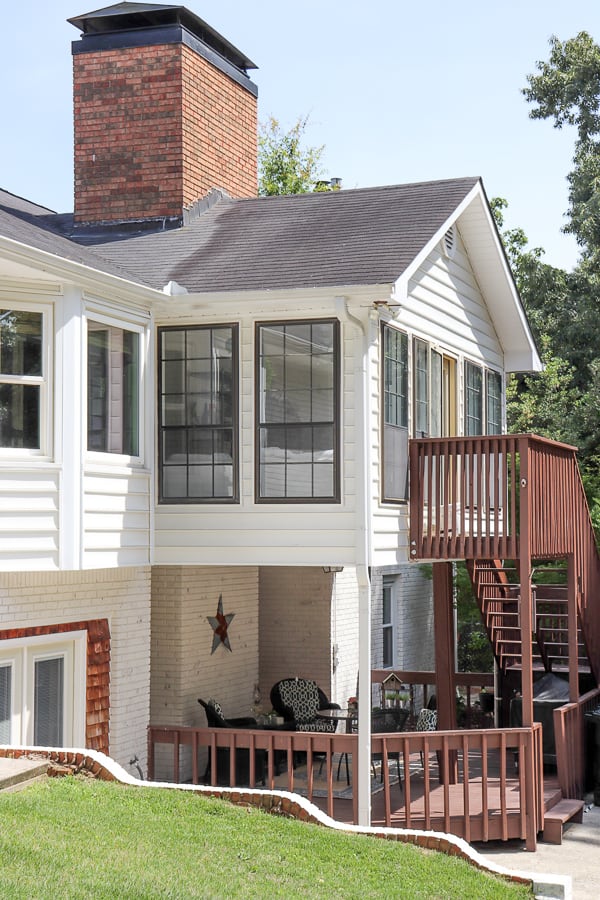
You have it in your mind – the gorgeous reveal of your beautifully lime washed home.
But you can’t get over that hurdle of messing it up. Or not liking it. Or some other reason – bees, heights, the outdoors – whatever it is, those fears can be greater than your vision.
Before Trent had become a PRO, climbing ladders was not his favorite activity.
Back in 2019, we had completed our entire home with the exception of our chimney stack.
The pitch of our roof with large drop offs made neither I nor my husband feel comfortable climbing that roof.
So we found a helper that Trent eventually hired when it came time to start his own Limewashing business.
While we may find this extremely easy to DIY, some people aren’t cut from the same cloth. That’s why Romabio has a list of PRO applicators that specialize in their products. The guesswork and fear are taken out of the equation for you.
So if this seems too daunting, then ask Romabio for a list of Preferred PRO Applicators in your area!
You may be on the fence whether to do this yourself or hire it out. I go over all the details of deciding whether or not to DIY or have someone do it for you (DIFM) in this post.
Have more questions?
I hope these 10 tips for limewashing your home helped answer some questions you may have.
I also answer more FAQs in this post if you didn’t find an answer you were looking for.
And you can always leave us a comment below. Trent and I are more than happy to share what we’ve learned along the way!
Check out these other Limewash Posts!
- Limewashing an Interior Accent Wall
- How to Lime Slurry a Brick Fireplace
- How to Lime Wash a Basket
- DIY Limewash Terra Cotta Lavender Plant
- How to Install and Limewash Brick Veneer
- 10 Tips for Limewashing Your Home
- How to Limewash a Brick Home
- Limewashing Your Home for Instant Curb Appeal
- Why We’re Limewashing Our Brick Home
- Limewashing our New Home – When to DIY or DIFM
- Limewashing a Painted Brick Fireplace
- Everything You Wanted to Know about Limewash



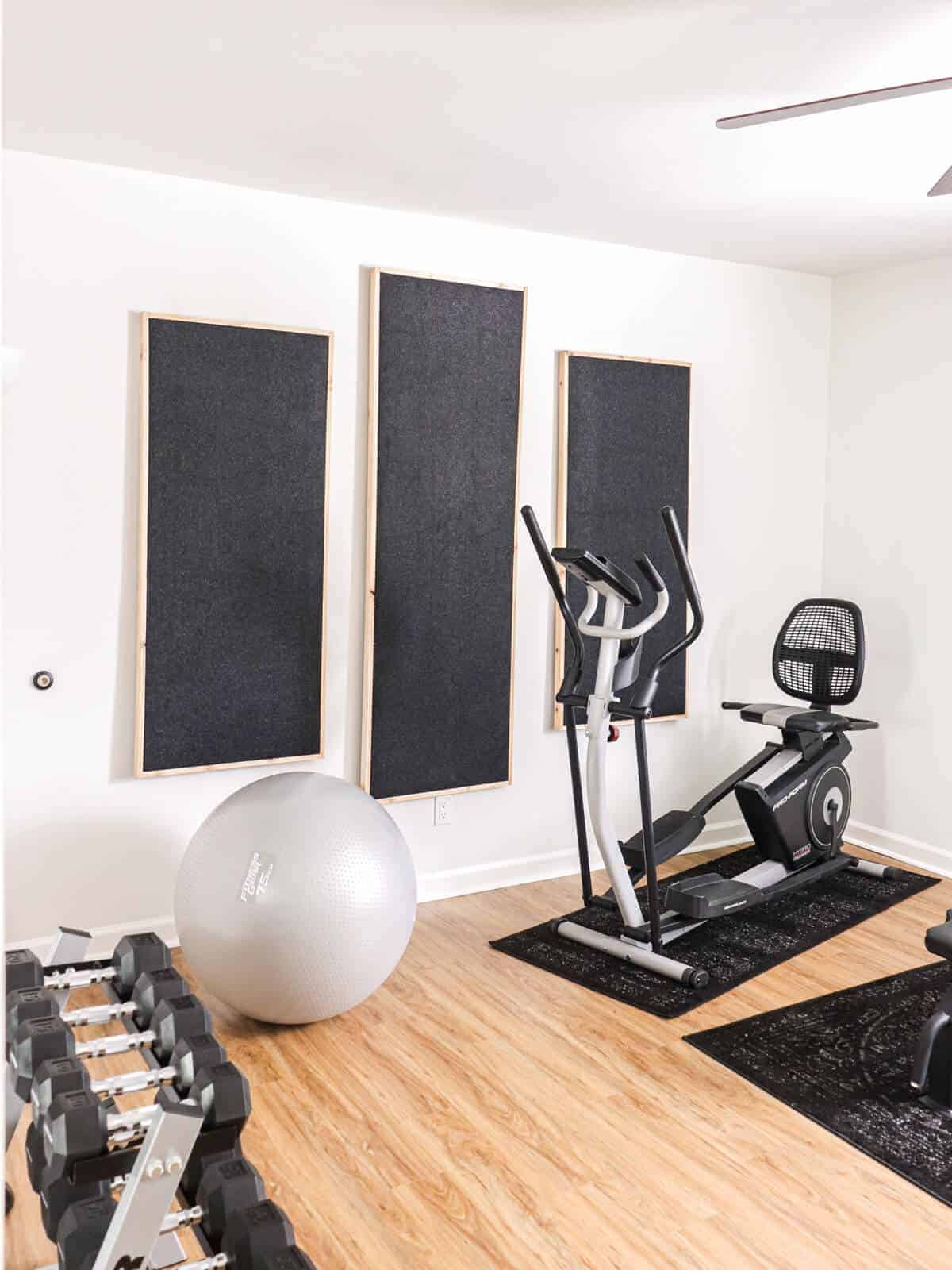
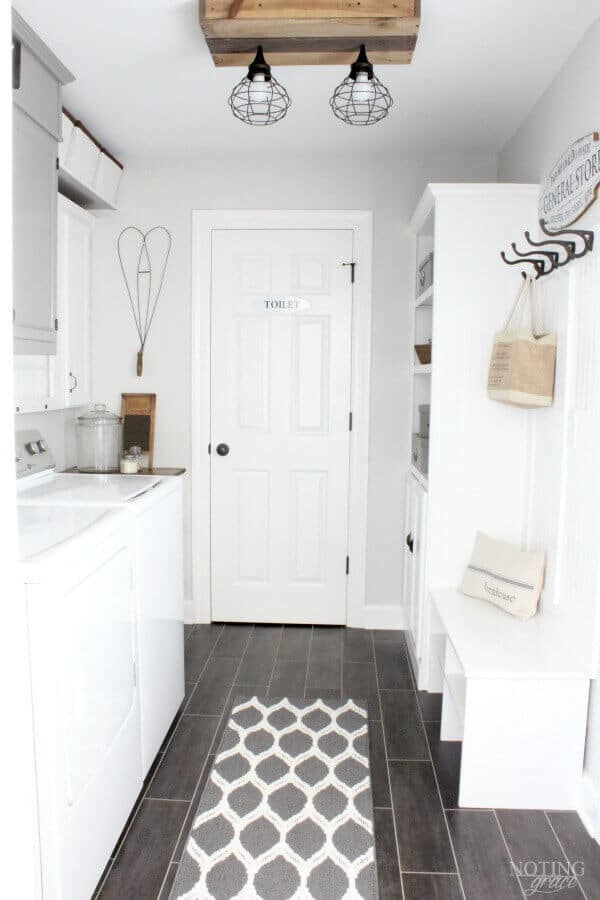

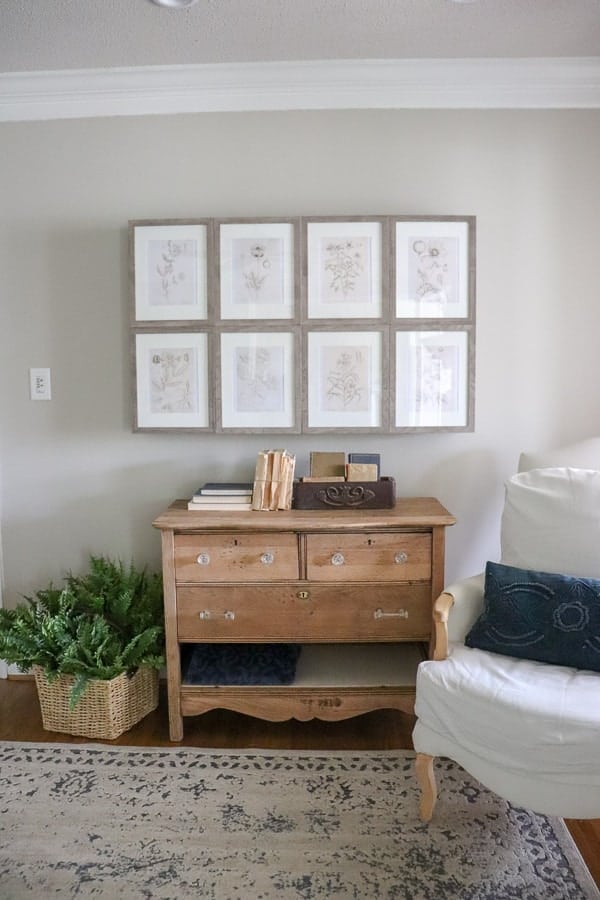
I’m in Texas, our house has siding, bricks and decorative rock. Is there any way to remove the sealant that’s on the rock so that I can Limewash my house? I sealed my turret last year, before I even knew limewashing was an option, and my house will look weird if I have siding, Limewashed brick, then the rocked turret. Thanks!
Hey Sommer –
So sorry to hear about the spots on your fireplace. And yes, those are tannins coming through. They used different materials to color the brick back in the 80s and those sometimes bleed through the Classico Limewash. I asked Romabio about it and they said to apply a stain blocking primer and then go over those spots with the Limewash again.
I know they have an awesome customer service team. You could always email them some photos and they could share some recommendations for how to solve it.
Hope that helps!
Jen
I just finished limewashing my 1980s orange brick fireplace and there are a few areas where after a week I have noticed some orange/brown areas develop around the actual fireplace screen… does this mean anything you by chance? I’ve been trying to do some research and the only thing I’ve come across is where there was a mention of ‘tannins’ but not a lot of info of what to do if so. I used my whole quart of lime wash so i cannot easily go over those areas again but I could buy another batch if this would work. I hate to use paint to cover this up but wondered if there is some type of primer that maybe is needed? I’m sure it is possible that those areas with that coloring could have. It been cleaned as thoroughly prior to me limewashing but it just seems strange and I just can’t leave ut like this. Thank you in advance for any help. Loved your post and I plan to read your idea for limewashing baskets!
Great question Chrysti! For black mortar, I would use a smaller brush and focus on that area first to make sure it gets full coverage. Once the mortar is brighter, then you can decide which areas of brick you would like to cover. Hope that helps!
Hi! Great article, I learned a lot! What would you do to limewash an interior fireplace that has black grout?
We had that same problem on one side of our house. First, pull any loose soil or mulch away from the brick. When we wet the brick before applying, we would lightly spray the bottom of the bricks to rinse off any mud that splashed up. And then we would cut in just as if you were painting above baseboards. Once it was dry, we pushed the mulch back in place and it looked great. Hope that helps!
Hello
Me and my husband have decided to go for it and lime wash our exterior brick home .. a small 1300 sq feet brick ranch.
Your tips and directions has been our go to!!! We have looked over our home exterior, matching up the color we chose to use (Romario Avoirio white)
We plan to begin this project in the next few weeks, weather permitting…
My question is any tips on painting at the bottom of our home . Our brick goes all the way to the ground .. we just want to take the proper steps and be as careful as possible to not get any dirt mixed in from the ground while painting the bottom of the home .
That’s a great question, Sarah. If the brick is old, many times the tannins they used to color the brick may be seeping through. It could also be rust. I suggest you reach out to Romabio. They have a great customer service team and have helped us many times with questions we’ve had.
Hi, this is so exciting and looks amazing! I’m getting ready to lime wash our red brick house and was doing a few test spots and noticed some darker discoloration coming through the lime wash in some areas. Do you know why it’s doing that or if there’s anyway to fix that?
Hey Jill! Thanks for reaching out! Romabio’s Classico Limewash is my favorite simply because it is DIY-friendly. It comes in 7 colors, but the most popular is Avorio White. For an average size fireplace, the 1 quart container is probably enough. Since you are doing an accent wall, it may be worth it to buy the 2.5L.
Hope that helps!
Hi,
Thank you for these tips. My husband and I want to limewash a stone accent wall in our living room. What product do I need to buy?
It’s so beautiful Jen!! I love the way it turned out!
It’s like you know what we’re planning over here!! Just bought a new mantel to go with our fireplace makeover later this Spring/Summer!! I’ll be coming back to this for sure!
Thank you, Brendt! We would love to help make that happen for you all! Your house would look awesome limewashed!
Jen,
You know how much I love this limewash look! It’s definitely a goal for our home.
Thank you for always inspiring me.
xoxo,
Brendt
Hi Ally! Certainly! We used a color from the Young House Love Collection with Romabio. It’s called Misty Eyed and is a great soft blue gray!
Hi Lisa – I’m so glad you took the time to leave a comment. I appreciate your opinion, but wanted to offer a bit more to help with the education process. Limewash has been around for ages, dating back to the Pharoah’s in Egyptian times. In fact, when one city burned during the Medieval era, the houses were ordered to be limewashed after noticing the only buildings left standing were those that the Limewash had been applied. The calcification process acts much like a stain being absorbed into and becoming part of the brick, unlike paint which just sits on top of the brick possibly causing damage to your most important investment. Many historical homes today are applying limewash to conserve the integrity of the brick.
I agree, everyone needs to do their homework before taking on a task as large as updating their exterior, but this fad has been around since B.C. and I don’t think it’s fading away anytime soon. Thanks for bringing up such a great talking point!
Like most trends, this will eventually go out of style & you’ll be left with a dated home. Before anyone jumps into limewashing or painting their home, they need to do some homework on what the cost/consequences of this decision. And most importantly, know what YOUR style is and don’t follow a trend just to be current.
How fun! Send me a pic of your home once you’re done – we’d love to see it! I got those light from Lamps Plus a little over a year ago.
The house looks great! We’re reviving a 70s colonial and did the Romabio lime wash on our brick. I’m writing to ask about your exterior wall lights by your front door. Can you share where you purchased them from? thx.
Can you tell me the paint color on the front door on the 5470 house? Love it
It really depends on many factors, like dilution rate and environment, as well as how much you distress it. For example a heavy distressing in a wet environment like the NW will see weathering quicker than an almost solid application in the dry, hot south.
But I’ve heard of homes that still look great 15 years later! Hope that helps!
Hi Jennifer,
How long does the lime wash last? My husband read that it has to be redone about every 5 years.
I hope not, love how your house looks and I want to do that to mine!
Thanks
Nora Olive
Hi Heidi! Thanks so much for reaching out! That’s a great question! We have limewashed 2 homes and used the masonry brush both times. If you search on my website, I’ve chronicled our limewash application for both houses. You can check those out if you are looking for more tips. And you can always email me or send me a message on social media. I’m happy to help!
Here is a link to all my Limewash posts:
LIMEWASH
My husband and I want to tackle Lime washing our home. Did either of you spray the Limewash on or use a masonry brush? I have started researching and need as much advice, suggestions, dos and donts before we start. Thank you for the helpful article!!
Thanks for asking Cindy! If your concrete isn’t sealed, the limewash should adhere. You may want to test an area first to make sure. In regards to application on a walkway, it isn’t typically recommended. Those areas get high foot traffic and will cause the limewash to wash away very quickly. Hope that answered your questions and thanks so much for reaching out!
Hi Melody! I’m so glad you enjoyed this post! In regards to your algae buildup, yes you want to make sure that is completely removed before applying. A good pressure washer should do the trick followed up by the algae remover. Hope that helps!
Hi April! That’s a great question! The main thing you want to look at are your non-changeables. For instance, if you aren’t planning on changing your roof for some time, take that into consideration. If it’s a warmer tone, you will want to choose a color that compliments that. Will you be painting your trim, shutters, or front door? If not, try a swatch next to those areas to see which one you like best. I hope that helps in finding a color to fit your home!
Hi, how did you know what color lime wash to use. On your house? That’s the problem I am having
Thank you
April
That was a fun blog hop! I really enjoyed reading about the differences in application techniques, and I also appreciated the before-after photos, which allows us to imagine how our own design sensibilities might affect the final outcome. Love what you’ve accomplished, and am inspired to get started on my own project, now.
I’m going to lime wash the bricks around my flowerbeds and am wondering what you’d suggest about the algae buildup in the shaded areas. I plan to use an algae remover, first. But does it have to be 100% algae-free before I apply the product.
I love this look. I wish I knew it worked on concrete. t
1. I would do or walkway.
2. I would use it on our foundation which is poured concrete.
Our decor is French Country. Would be so happy.
You did a fantastic job
Cindy